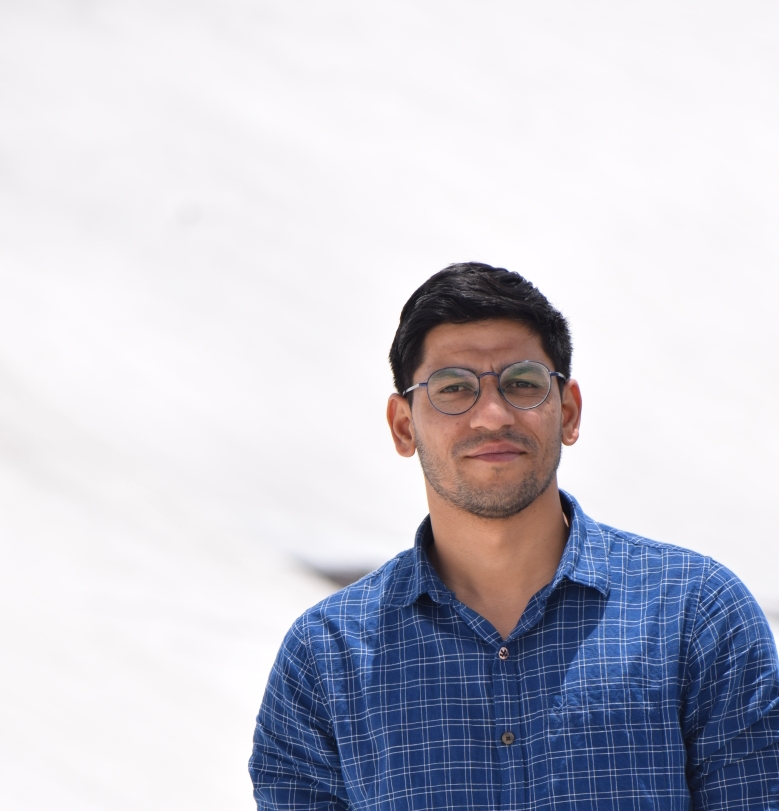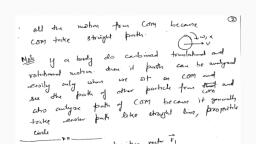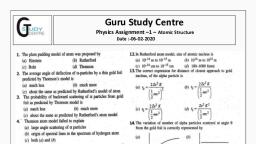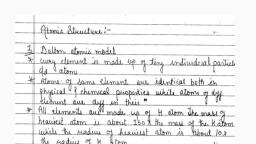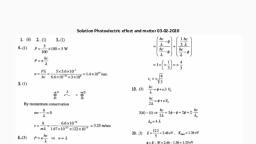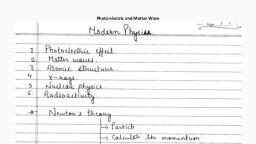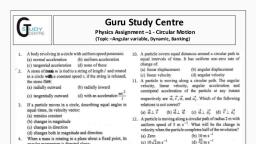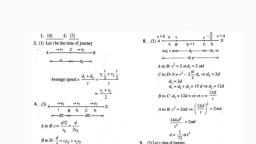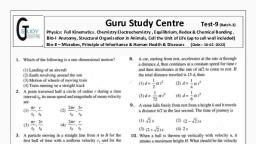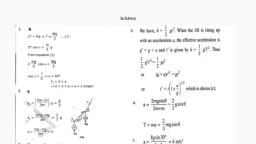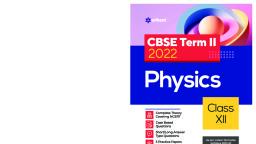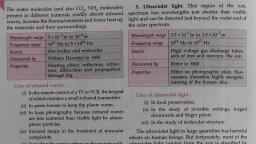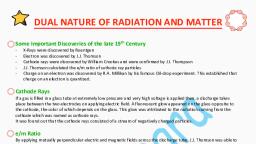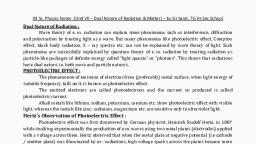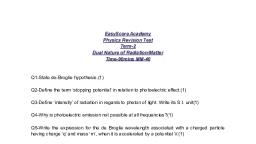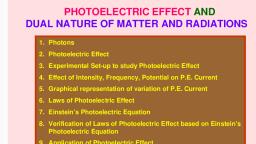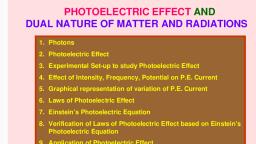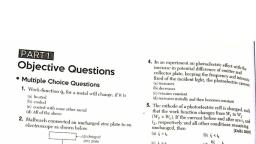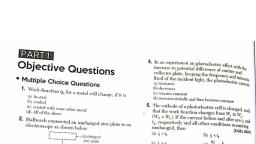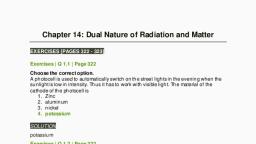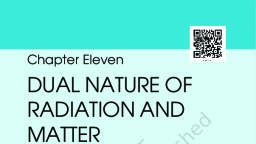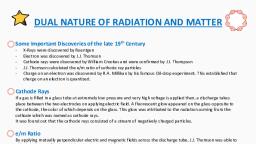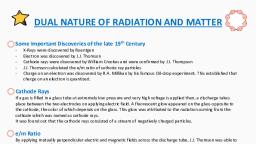Page 1 :
Guru Study Centre, UDY, CENTRE, Physics Assignment -1 - Photoelectric effect and Matter, Date :-03-02-2020, 1. Which of the following is correct regarding photons?, (i) A photon always travels at a speed 3 x 10 m/sec in, 7., Which of the following is correct regarding photo-electric, effect?, (i) The photo-electric effect takes place if à < or, v 2 . The maximum K.E. of photo-electron, vacuum., (ii) The rest mass of photon is zero., (iii) Let E and p be the energy and linear momentum of a, photon and v and a be the frequency and wavelength, of the same light when it behaves as a wave. Then, K., he, = hv =, max, Einstein photo-electric effect equation, hv= hu, + Kmax, hc, E = hv=, (ii) The maximum K.E. of electron or stopping potential, V, (Kmas = eV,) for a given metal depends only on, frequency or wavelength of incident light and not on, its intensity, hv h E, !!, (iv) A photon may collide with a material particle., The total energy and the total momentum remain, conserved in such a collision. The photon may get, absorbed and/or a new photon may be emitted. Thus,, the number of photons may not be conserved., (iii) The saturation current (i = ne, n: number of photo-, electrons ejected per unit time) depends on intensity, and not frequency, (iv) Normally it is assumed that one photon eject one, electron. Practically several incident photons eject, one electron. If quantum efficiency is given, (1) (), (i), (ii), (2) (ii), (ii), (iv), (3) (i), (ii), (iv), (4) All of the above., 2. Let p and E denote the linear momentum and energy of a, photon. If the wavelength is decreased,, (1) both p and E increase, (2) p increases and E decreases, (3) p decreases and E increases, (4) both p and E decreases, 3. The energy of a photon in eV of wavelength A nm will, Number of electrons ejected, Quantum efficiency, Number of photons incident, Number of electrons ejected must be calculated and then, calculate saturation current, (1) (i), (ii), (ii), (3) (i). (iii), (iv), (2) (ii), (iii), (iv), (4) all, 8., Which of the following is correct regarding Einstein, photo-electric effect equation?, (i) The equation is hv= hu+ Kmax = h +eV,, (ii) The variation of V, with v is, be, 1242, (1) E(eV) =, 2(nm), 1000, (2) E(eV) =, A(nm), Slope: m = tan 8 =, huo, 500, (3) E(eV) =, A(nm), 250, (4) E(eV) =, A(nm), 4. If 5% of the energy supplied to a bulb is radiated as visible, light, the number of visible quanta emitted per second by, a 100 W bulb, assuming the wavelength of visible light to, be 5.6 x 10 cm is, (1) 1.4 x 1019, (3)2 x 1019, 5. A hydrogen atom moving at a speed v absorbs a photon, of wavelength 122 nm and stops. The value of v is (mass, of hydrogen atom = 1.67 x 10" kg), (1) 3.25 m/sec, (3) 9.25 m/sec, (iii) The variation of photo-current versus applied, potential, Saturation, current, (2) 1.4 x 1020, (4) 2x 1020, (iv), (2) 6.25 m/sec, (4) 12.25 m/sec, 6. Let n, and ng be respectively the number of photons, emitted by a red bulb and a blue bulb of equal power in a, given time, (1) n, = n,, (3) п, > п,, Is, 12, (2) n,<n, (4) none, GURU STUDY CENTRE (KACHERI ADDA, DHARAMSHALA DISTT. KANGRA) CONTACT US :- 8629073248,, 1, 8988076292, 9882983453 EMAIL:- GURUSTUDY82@GMAIL.COM, Www.GURUSTUDYCENTRE.COM
Page 2 :
14. In photoelectric effect, (1) photons come out of a metal when it is hit by a beam, of electrons, Metal2, Metal,, Metals, (2) photons come out of the nucleus of an atom under the, action of an electric field, Vs, (1) (), (i), (ii), (2) (ii), (ii), (iv), (3) (1), (ii), (iv), (3) electrons come out of a metal with a constant velocity, which depends on the frequency and intensity of, incident radiation, (4) electrons come out of a metal with different velocities, not greater than a certain value which depends only, on the frequency of the incident light and not on its, intensity, (4) all, 9. As the intensity of incident light increases, (1) photoelectric current increases, (2) photoelectric current decreases, (3) kinetic energy of emitted photoelectrons increases, (4) kinetic energy of emitted photoelectrons decreases, 10. The number of photo-electrons emitted per second from a, metal surface increases when, 15. A metallic surface ejects electrons when exposed to green, light of intensity /but not when exposed to yellow light of, intensity I. It is possible to eject electrons from the same, surface by, (i) yellow light of some intensity which is more than I, (ii) green light of any intensity, (iii) red light of any intensity, (iv) violet light of any intensity, (1) (i), (ii), (3) (i), (iv), (1) the energy of incident photons increases, (2) the frequency of incident light increases, (3) the wavelength of the incident light increases, (4) the intensity of the incident light increases, 11. Photons of frequency v fall on a metal surface for which, the threshold frequency is (v2 ). Then,, (1) all ejected electrons have the same K.E. h(v-), (2) the ejected electrons have a distribution of kinetic, energy from zero to h(v-), (3) the most energetic electrons have K.E. hv, (4) the average K.E. of ejected electrons is hu, 12 Which of the following statements about photoelectric, effect is/are false?, (i) It exhibits the particle nature, (ii) Electrons are emitted only if the radiation has a, frequency above a certain value, (iii) All the electrons emitted by radiation of a particular, frequency have the same energy, (iv) Changing the intensity of radiation changes the, maximum energy with which the electrons can be, emitted, (2) (ii), (ii), (4) (ii), (iv), 16. Light of two different frequencies whose photons have, energies 1 eV and 2.5 eV successively illuminate a metal, of work function 0.5 eV. The ratio of the maximum speeds, of the emitted electrons will be, (1) 1:5, (3) 1:2, 17. Two identical photo-cathodes receive light of frequencies, fj and f. If the velocities of the photo electrons ( of mass, m) coming out are respectively v, (2) 1:4, (4) 1:1, and, V2, then, 2h, (1) v, -v, =, 2h, (2) v -v =-), %3D, m, 2h, (3) v, +v, =, 2h, (4) v +v = "+5), m, 18. In a photoemissive cell with exciting wavelength 2, the, fastest electron has speed v. If the exciting wavelength is, changed to 3A/4, the speed of the fastest emitted electron, will be, (1) (), (i), (3) (1), (iv), 13. When stopping potential is applied in an experiment on, photoelectric effect, no photo current is observed. This, (2) (ii), (ii), (4) (iii), (iv), (1) v(3/4)2, (3) less than v(4/3)2 (4) greater than v(4/3)2, (2) v(4/3)2, 19. Whenametallic surface is illuminated by a monochromatic, light of wavelength , the stopping potential for, photoelectric current is 3Vo. When the same surface, means that, (1) the emission of photoelectrons is stopped, (2) the photoelectrons are emitted but are re-absorbed by, the emitter metal, is illuminated by light of wavelength 22, the stopping, potential is Vg. The threshold wavelength for this surface, for photoelectric effect is, (1)62, (3) 4 2, (3) the photoelectrons are accumulated near the collector, plate, (2) 3 2, (4) 8 2, (4) the photoelectrons are dispersed from the sides of the, apparatus, GURU STUDY CENTRE (KACHERI ADDA, DHARAMSHALA DISTT. KANGRA) CONTACT US :- 8629073248,, 8988076292, 9882983453 EMAIL:- GURUSTUDY82@GMAIL.COM, Www.GURUSTUDYCENTRE.COM
Page 3 :
A photon of wavelength 1000 A has energy 12.3 eV. If, light of wavelength 5000 Å, having intensity I, falls on, a metal surface, the saturation current is 0.40 µA and the, stopping potential is 1.36 V. The work function of metal, is, 29.. Light of frequency 1.5 times the threshold frequency is, incident on a photo-sensitive material. If the frequency, is halved and the intensity is doubled, the photoelectric, 20., current becomes, (1) four times (2) double (3) half, 30. Ifthe wavelength oflight in an experiment on photoelectric, effect is doubled,, (4) zero, (1) 2.47 eV, (3) 1.10 eV, (2) 1.36 eV, (4) 0.43 eV, (i) the photoelectric emission will not take place, (ii) the photoelectric emission may or may not take, place, (iii) the stopping potential will increase, (iv) the stopping potential will decrease, (1) (i), (ii), (3) (i), (iv), When ultraviolet radiation is incident on a surface, no, photoelectrons are emitted. If another beam causes, photoelectrons to be emitted from the surface, it may, consist of, 21. In the previous question, if the intensity of light is made, 41, the stopping potential will become, (1) 1.36 V, (3) 1.36 x 4 V, (2) 1.36 x 2 V, (4) 1.36 x 16 V, 22.. In question 21, if the intensity of light is made 4 I, the, saturation current will become, (2) (ii), (iii), (4) (i), (iv), (2) 0.4 x 2 µA, (4) 0.4 x 16 µA, 23. For a certain metal the threshold frequency is u, If light, of frequency 2 u is incident on it the electrons come out, with a maximum velocity of 4 x 10 m/sec. If light of, frequency 5 u, is incident on it, the maximum velocity of, (1)0.4 µA, (3) 1.6 µA, 31., (i) radio waves, (iii) X-rays, (1) (), (ii), (3) (i), (iv), 32., (ii) infrared rays, (iv) gamma rays, (2) (ii), (iii), (4) (ii), (iv), electrons will be, (1)4 x 10° m/sec, (3) 8 x 10° m/sec, (2) 6x 10 m/sec, (4) 16 x 10° m/sec, 24. In an experiment on photoelectric effect, light of, wavelength 400 nm is incident on a cesium plate at the, rate of 5.0 W. The potential of the collector plate is made, sufficiently positive with respect to the emitter so that the, current reaches its saturation value. Assuming that on the, average one out of every 10° photons is able to eject a, photoelectron, the photocurrent in the circuit is, (2) 0.8 µA, ( 4) 1.6 μΑ, 25. If Planck's constant is denoted by h and the charge, by e, experiments on photoelectric effect allow the, A non-monochromatic light is used in an experiment on, photoelectric effect. The stopping potential, (1) is related to the mean wavelength, (2) is related to the longest wavelength, (3) is related to the shortest wavelength, (4) is not related to the wavelength, 32.. A point source of light is used in a photoelectric effect. If, the source is removed farther from the emitting metal, the, stopping potential, (1) will increase, (3) same, 33., (1) 0.4 µA, (3) 1.2 µA, (2) will decrease, (4) none, Photoelectric effect supports quantum nature of light, because, (i) there is a minimum frequency below which no, photoelectrons are emitted, (ii) the maximum kinetic energy of photoelectrons, depends only on the frequency of light and not on its, intensity, (iii) even when the metal surface is faintly illuminated the, photoelectrons leave the surface immediately, (iv) electric charge of the photoelectrons is quantized, (1) (i), (ii), (ii), (3) (i), (ii), (iv), 34. The cathode of a photoelectric cell is changed such that, the work function changes from W, to W, (W2 > W,). If, the current before and after change are i, and i, all other, conditions remaining unchanged, then (assuming hu>W,), determination of, (1) only h, (3) both h and e, (2) only e, (4) only hle, 26. In order to increase the kinetic energy of ejected, photoelectrons, there should be an increase in, (2) 2, (4) both 2 and I, 27. In photoelectric emission the number of electrons ejected, (1)I, (3) v, (2) (ii), (i), (iv), (4) all, per second is proportional to the, (1)I, (3) v, (2) 2, (4) W, 28. . When monochromatic radiation of intensity I falls on a, metal surface, the number of photoelectrons and their, maximum kinetic energy are N and T respectively. If the, intensity of radiation is 21, the number ofemitted electrons, and their maximum kinetic energy are respectively., (1) i = i,, (3) i, > iz, (2) i, <iz, (4) i, <i,< 2i,, (1) N and 27, (3) 2N and 27, (2) 2N and T, (4) N and T, GURU STUDY CENTRE (KACHERI ADDA, DHARAMSHALA DISTT. KANGRA) CONTACT US :- 8629073248,, 3, 8988076292, 9882983453 EMAIL:- GURUSTUDY82@GMAIL.COM, Www.GURUSTUDYCENTRE.COM
Page 4 :
35. The frequency and intensity of a light source are both, doubled. Consider the following statements, A. The saturation photocurrent remains almost the same, B. The maximum kinetic energy of the photoelectrons is, doubled, (1) Both A and B are true, (2) A is true but B is false, (3) A is false but B is true, (4) Both A and B are false, 36. The threshold wavelength for photoelectric emission from, a material is 5200 Ă. Photoelectrons will be emitted when, this material is illuminated with monochromatic radiation, from a lamp, 41. Photoelectric effectexperiments are performed using three, different metal plates p, q and r having work functions, 9, = 2.0 eV, 0, = 2.5 eV and o, = 3.0 eV, are respectively., A light beam containing wavelength of 550 nm, 450 nm, and 350 nm with equal intensities illuminates each of the, plates. The correct I-V graph for the experiment is (take, hc = 1240 eV nm), (1), (2), V, (4), (i) 50 W infrared, (iii) 50 W ultraviolet (iv) 1 W ultraviolet, (1) (), (i), (3) (1). (iv), (ii) 1 W infrared, (3), (2) (ii), (ii), (4) (ii), (iv), 37. A photocell is illuminated by a small bright source placed, Im away. When the same source of light is placed 2 m, away, the electrons emitted by the photocathode, (1) carry 1/4 of their previous energy, (2) carry 1/4 of their previous momenta, (3) are 1/2 as numerous, (4) are 1/4 as numerous, 38. If the distance of 100 Watt lamp is increased from a, photocell, the saturation current i in the photo cell varies, with distance d as, 42. The graph 1/2 and stopping potential (V) of three metals, having work functions o, , and , in an experiment of, photo-electric effect is plotted as shown in the figure., Which of the following statement(s) is/are correct? [Here, A is the wavelength of the incident ray], Metal 1 Metal 2 Metal 3, V, (2) i c d, (4) i x d, (1) i« d, (3) i x d, 39. When a monochromatic point source of light is at a, distance of 0.2 m from a photoelectric cell, the cut-off, voltage and the saturation current are respectively 0.6 volt, and 18.0 mA. If the same source is placed 0.6 m away, from the photoelectric cell, then, (i) V, = 0.2 V, (iii) i = 6 mA, (1) (1), (i), (3) (i), (iv), 40. A photon of energy E ejects a photoelectron from a metal, surface whose work function is , If this electron enters, into a uniform magnetic field of induction B in a direction, perpendicular to the field and describes a circular path, of radius r, then the radius r, is given by, (in the usual, notation), (nm-1), 10.001 0.002 0.004, (i) Ratio of work functions o: : 1:2:4, (ii) Ratio of work functions o,: : 0, = 4:2:1, (iii) tan 8 is directly proportional to hcle, where h is, Planck's constant and c is the speed of light, (iv) The violet colour-light can eject photoelectrons from, metals 2 and 3, (ii) V, = 0.6 V, (iv) i = 2.0 mA, (2) (ii), (ii), (4) (ii), (iv), (2) (). (iv), (4) (i), (i), (iv), 43.. The figure shows a plot of photo current vers, potential for a photo sensitive surface for three different, radiations. Which one of the following is a correct, (1) (i). (ii), (3) (ii), (ii), anode, statement, Photo current, 2m(E-o), (1)., (2) 2m(E-0) eB, eB, 2e(E-o), 2m(E-0), (4), m B, Be, Retarding, potential, Anode potential, GURU STUDY CENTRE (KACHERI ADDA, DHARAMSHALA DISTT. KANGRA) CONTACT US :- 8629073248,, 4, 8988076292, 9882983453 EMAIL:- GURUSTUDY82@GMAIL.COM, Www.GURUSTUDYCENTRE.COM
Page 5 :
(1) curves a and b represent incident radiations of different, frequencies and different intensities, (2) curves a and b represents incident radiations of same, frequency but of different intensities, (3) curves b and c represents incident radiations of, different frequencies and different intensities, (4) curves b and c represents incident radiations of same, frequency having same intensity, 44. Which of the following is correct regarding de-Broglie, wavelength?, (1) Every moving particle has a wave associated, with it and is given by de-Broglie wavelength, 49. In the Davission and Germer experiment, the velocity of, electrons emitted from the electron gun can be increased, by, (1) decreasing the potential difference between the anode, and filament, (2) increasing the potential difference between the anode, and filament, (3) increasing the filament current, (4) decreasing the filament current, 50.. When the energy of the incident radiation is increased, by 20%, the kinetic energy of the photoelectrons emitted, from a metal surface increased from 0.5 eV to 0.8 eV. The, work function of the metal is, h, 入=ー=, h, mv 2mK, (1) 1.0 eV, (2) 1.3 eV, (3) 1.5 eV, (4) 0.65 eV, (2) Whether wave behaviour will dominate or particle, behaviour, it depends on the dimension of object with, which particle interacts, (3) The variation of de-Broglie wavelength 2 with, momentum of particle p, 51. Light with an energy flux of 25 x 10* Wm falls on a, perfectly reflecting surface at normal incidence. If the, surface area is 15 cm, the average force exerted on the, surface is, (1) 2.50 x 10N, (2) 1.20 x 10N, (3) 3.0 x 10 N, (4) 1.25 x 10N, If the kinetic energy of the particle is increased to 16, times its previous value, the percentage change in the, de-Broglie wavelength of the particle is, 52., (4) All options are correct, 45. An electron and a proton are accelerated through the same, potential. If their masses are m, and m, respectively, then, the ratio of their de-Broglie wavelength is, (1) 75, (2) 60, (3) 50, (4) 25, 53. The least energy required to eject an electron from the surface of, a metal is called, (a) kinetic energy, (c) electrical energy, 54. The least energy required for the electrons emission from the, metal surface can be supplied to the electrons by which of the, following processes ?, (a) Thermionic emission, (1) 1, (b) work-functional energy, m, (4), m, (d) fermi energy, m., 46.. The de-Broglie wavelength of a neutron at 27°C is A., What will be its wavelength at 927°C, (b) Photoelectric emission, (2) 1/3, (4) A/9, (1) 1/2, (3) 1/4, 47. , and Ag are the de-Broglie wavelength of electron,, proton and a particle. If all the accelerated by same, potential, then, (c) Field emission, (d) All of them, 55. Out of the following statements, which one is true ?, (a) Work function of a metal increases with the increase in, temperature., (1)るくろくん。, (3) 4, > 2, > ha, (2) ふくる>。, (4) 4 =4,> ha, (b) Work function of a pure metal is more than a metal coated, with oxide layer., (c) The value of work function is more for lead than for platinum, 48. Matter waves are, (d) All these statements are true., (1) electromagnetic waves, (2) transverse mechanical waves, 56.. The work function of à metal is , and the frequency of incident, light is v, there is no emission of photoelectrons when:, (h = Plank'o constant), (3) longitudinal mechanical waves, (4) neither electromagnetic nor mechanical waves, (@) v= Q/h, (c) v > /h, (b) v</h, () v20h, GURU STUDY CENTRE (KACHERI ADDA, DHARAMSHALA DISTT. KANGRA) CONTACT US :- 8629073248,, 8988076292, 9882983453 EMAIL:- GURUSTUDY82@GMAIL.COM, Www.GURUSTUDYCENTRE.COM
